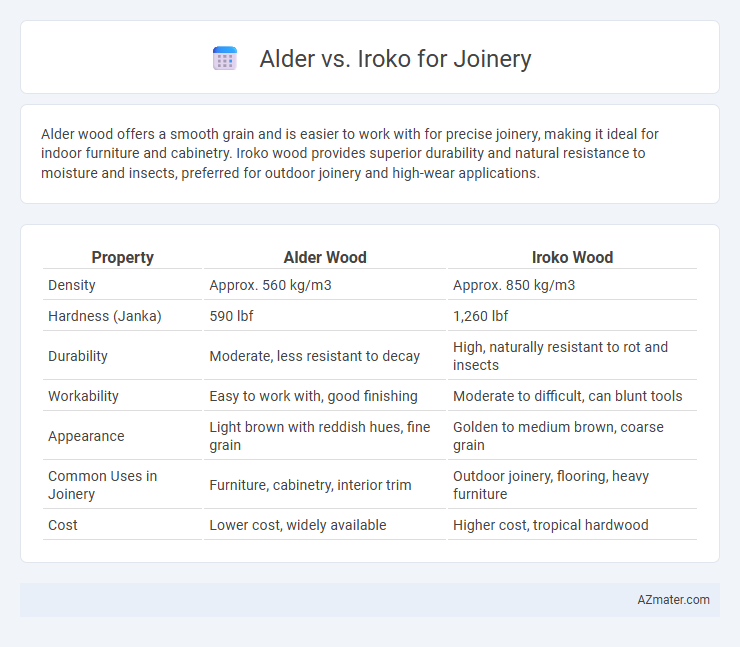Alder wood offers a smooth grain and is easier to work with for precise joinery, making it ideal for indoor furniture and cabinetry. Iroko wood provides superior durability and natural resistance to moisture and insects, preferred for outdoor joinery and high-wear applications.
Table of Comparison
| Property | Alder Wood | Iroko Wood |
|---|---|---|
| Density | Approx. 560 kg/m3 | Approx. 850 kg/m3 |
| Hardness (Janka) | 590 lbf | 1,260 lbf |
| Durability | Moderate, less resistant to decay | High, naturally resistant to rot and insects |
| Workability | Easy to work with, good finishing | Moderate to difficult, can blunt tools |
| Appearance | Light brown with reddish hues, fine grain | Golden to medium brown, coarse grain |
| Common Uses in Joinery | Furniture, cabinetry, interior trim | Outdoor joinery, flooring, heavy furniture |
| Cost | Lower cost, widely available | Higher cost, tropical hardwood |
Introduction: Comparing Alder and Iroko for Joinery
Alder wood features a fine, even grain with a light reddish-brown hue, making it ideal for detailed joinery and indoor furniture due to its workability and smooth finish. Iroko, a dense hardwood native to Africa, offers exceptional durability and resistance to moisture and decay, making it suitable for exterior joinery and heavy-use applications. When choosing between Alder and Iroko, factors such as aesthetic preference, environmental exposure, and project longevity play crucial roles in determining the best fit for joinery needs.
Botanical Overview: Alder vs Iroko
Alder (Alnus glutinosa) is a deciduous hardwood native to Europe and North America, characterized by its fine, even texture and light reddish-brown color, making it ideal for detailed joinery work. Iroko (Milicia excelsa), a tropical hardwood from West Africa, features a coarse grain and a rich golden to medium brown hue with interlocking fibers, offering superior durability and resistance to decay in joinery applications. The contrasting botanical properties influence their performance, with Alder prized for smooth finishes and Iroko favored for robust structural joinery.
Appearance and Color Differences
Alder wood features a fine, straight grain with a smooth texture and displays warm, reddish-brown hues that darken over time, making it ideal for joinery projects seeking a cozy, inviting appearance. Iroko boasts a more pronounced, coarse grain with golden to medium brown tones that can develop a rich, deep patina, offering a striking contrast for bold, durable joinery elements. The distinct color stability and grain patterns of Alder and Iroko greatly influence their suitability for different aesthetic preferences in woodworking and interior design.
Workability and Machinability
Alder wood is highly praised for its excellent workability, offering a smooth texture and ease of cutting, shaping, and sanding, making it ideal for intricate joinery projects. Iroko, while harder and denser, provides good machinability but requires sharper tools and more careful handling due to its interlocked grain and oil content, which can cause tool wear. Both woods deliver durability and a fine finish, but alder is generally preferred when superior ease of machining and detail precision is critical in joinery.
Durability and Resistance to Decay
Iroko wood, known for its exceptional durability and natural resistance to decay, outperforms Alder in joinery applications exposed to moisture and pests. Alder, while easier to work with due to its softer texture, lacks the inherent rot resistance and longevity that Iroko provides, making it less suitable for outdoor or high-humidity environments. For long-lasting joinery projects requiring robust protection against decay, Iroko is the superior choice compared to Alder.
Environmental Impact and Sustainability
Alder wood is a fast-growing hardwood native to North America, offering a lower environmental impact due to its rapid renewability and minimal chemical treatment requirements in joinery. Iroko, sourced from African tropical forests, is highly durable and resistant to decay but raises sustainability concerns because of deforestation and slower growth rates. Choosing alder supports eco-friendly joinery projects with a reduced carbon footprint, while Iroko's longevity can offset its environmental cost when sourced from certified sustainable plantations.
Cost Considerations
Alder wood tends to be more affordable for joinery projects due to its faster growth rate and wider availability compared to Iroko, which is a dense, hardwood often imported from West Africa. Iroko's higher price reflects its durability, resistance to decay, and suitability for outdoor applications, making it cost-effective for long-term use despite initial expense. When budgeting, choose Alder for budget-friendly indoor joinery and Iroko when investing in longevity and weather resistance for outdoor or heavy-duty joinery work.
Common Joinery Applications
Alder wood is favored in joinery for its fine grain and smooth texture, making it ideal for detailed interior applications such as cabinetry, furniture, and decorative moldings. Iroko offers superior durability and resistance to moisture, which suits it well for exterior joinery tasks including window frames, doors, and outdoor furniture. Both woods serve specialized roles in common joinery projects, with alder excelling in aesthetic-focused indoor uses and iroko providing strength and longevity in harsher environments.
Maintenance and Longevity
Alder wood requires minimal maintenance but is less durable compared to Iroko, which is highly resistant to decay and insect attacks, making it ideal for long-lasting joinery. Iroko's natural oils provide excellent protection against weathering, reducing the need for frequent refinishing and ensuring extended longevity. Choosing Iroko for joinery offers superior durability and lower upkeep costs, especially in high-moisture or outdoor environments.
Conclusion: Choosing the Right Wood for Your Project
Alder wood offers a smooth grain and easy workability, making it ideal for fine joinery projects and indoor furniture requiring a warm, consistent finish. Iroko provides exceptional durability and resistance to moisture and decay, suited for outdoor joinery, high-traffic areas, and heavy-use applications. Selecting between Alder and Iroko depends on project requirements such as exposure, desired finish, and longevity, with Alder favored for interior aesthetics and Iroko chosen for robust, weather-resistant joinery.

Infographic: Alder vs Iroko for Joinery
 azmater.com
azmater.com